 In 1936 another division was added; the Air Ministry issued Zündapp the contract to build a high performance airplane engine. The Ernst Schmidt designed air-cooled inline four-cylinder had two liters and made 50 hp. Under the name Zündapp Z9-092 it was used in smaller aircraft such as the terminal KL105, or Fieseler Fi 253 In 1936 another division was added; the Air Ministry issued Zündapp the contract to build a high performance airplane engine. The Ernst Schmidt designed air-cooled inline four-cylinder had two liters and made 50 hp. Under the name Zündapp Z9-092 it was used in smaller aircraft such as the terminal KL105, or Fieseler Fi 253
Throughout the 1930s Zündapp had delivered many K models to the Reichswehr but these were basically just enhanced civilian machines. At the end of 1937 the army arms unit in Berlin demanded a bike that would carry a payload of 500kg which corresponded to three soldiers with arms, ammunition and full equipment; fully loaded it needed to be able to maintain a permanent speed of 80kph on the autobahn, possess a top speed of 95kph and, to accompany marching troops, be capable of maintaining a minimum of 4kph. Cross-country 4.5 x 16 tires had to be be used (interchangeable with those on VW’s Kubelwagen), minimum ground clearance had to be 150mm and the mudguards needed sufficient clearance to allow for the fitment of snow chains. By 1939 Zündapp had built two 700cc prototypes that went to the OKH for testing. BMW had also been asked to develop a similar bike but after testing both the Zündapp KS750 and the BMW R75, the KS was found to be superior. BMW were asked if they would build the KS under license but they refused, although they did later adopt the two-wheel drive and hydraulic brake system.
 In August 1942 Zündapp and BMW, on the urging of the Army, agreed upon standardization of parts for both machines, with a view of eventually creating a Zündapp-BMW hybrid, in which a 286/1 side-car would be grafted onto a Zündapp KS 750 motorcycle. They also agreed that the manufacture of the R75 would cease once production reached 20,200 units, and after that point BMW and Zündapp would only produce the Zündapp-BMW machine, manufacturing 20,000 each year.
In the following years, the company experienced a steady upswing. Beginning in 1940 the company had change over to armament manufacture and was now producing motorcycles and small tanks for the Wehrmacht; Zündapp produced more than 18,000 units of the Zündapp KS750, mostly as a sidecar outfit. But by 1944 the factory had been bombed into rubble and over two thirds of the machinery was lost. A further 98 units were assembled by the Soviets in 1946 as reparations, and In 1954 a small number of modified R75’s was produced at Eisenach (then in Soviet-controlled East Germany) for testing under the designation AWO 700, but were never put into full production.
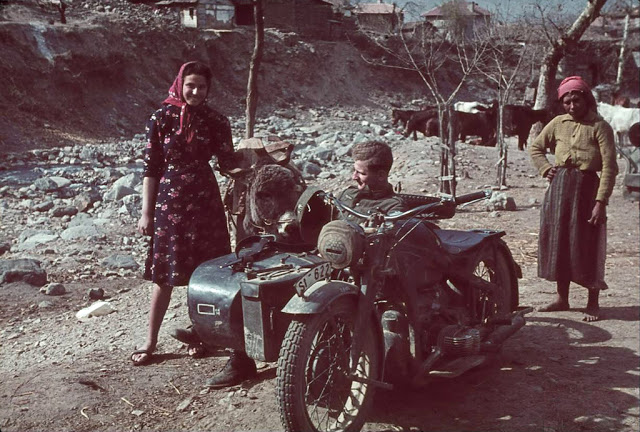 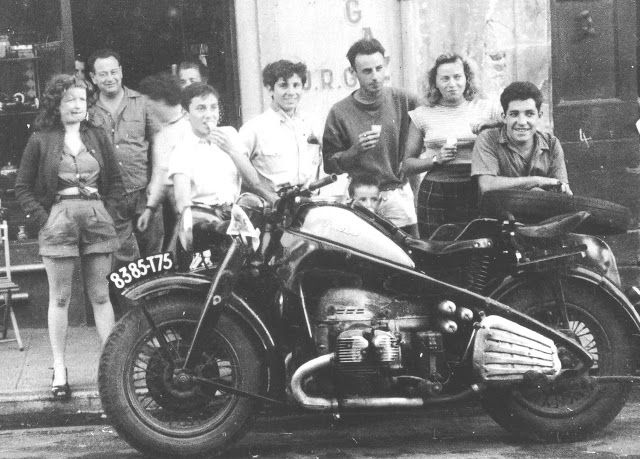 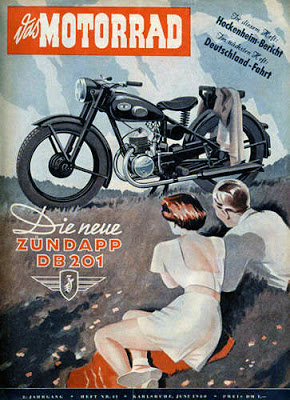
After the war motorcycle production was initially banned, and the remains of the company consolidated to manufacture grain milling equipment. Because new clothing remained in short supply a large home based industry quickly sprang up to repair and alter secondhand clothes, creating a high demand for both household and professional sewing machines. The Zündapp factories were still in the process of rebuilding but they quickly converted their remaining equipment to sewing machine manufacture.
Motorcycle production lines finally started up again in 1947 and in 1950 a branch factory was established in Munich employing some 1,700 people. Their first new production bike was the DB201, based on the “Derby” series DB200 (also known as the “bauer motorrad” or “farmer’s motorcycle”) that had been one of their more popular machines from 1935 – 1940. The DB201 was built to pre-war specs but almost immediately upgraded as finances permitted: a 7hp 198cc, 3 speed chain drive provided up to 85 kph.
 |
| DB201 |
In 1951 Zündapp developed the KS601, their first “heavy” motorcycle since the war. The newly designed 597cc boxer motor with dual Bing carburetors produced 28 Hp at 4700 rpm with peak torque of 33.6 Ft. Lbs at 4000 Rpm: this was more powerful than the Volkswagen, and it made the KS-601 an immediate hit with enthusiasts.
It also sported telescopic forks (as opposed to the traditional Zündapp parallel four link forks) and plunger rear suspension. The fenders, tool box, fuel tank, fork cover and head light housing were painted green, partially to distinguish it from BMW, and it soon earned the well known title of “Green Elephant”.
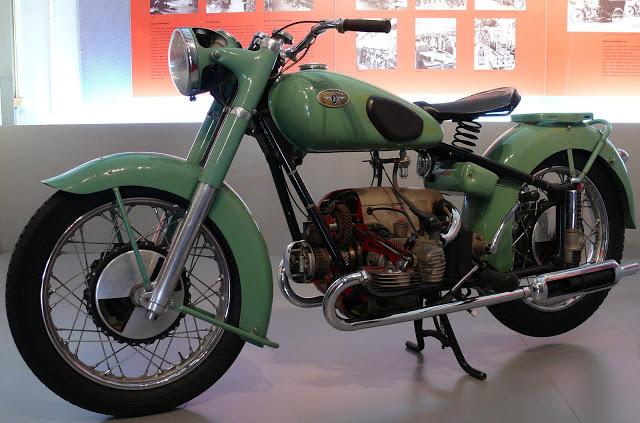 |
| KS601 with engine cutaway |
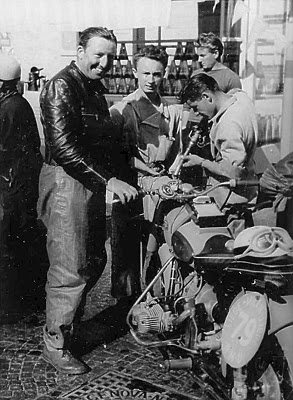 |
Werner Kritter, KS601 – first place in sidecar category,
1953 Liège – Milan – Liège |
The bike received enthusiastic reviews from various motoring magazines, and initially proved popular with both the motor sports crowd and average owners who quickly came to appreciate its rugged dependability.
In 1954, a father and son team rode a Zündapp KS601 on a highly publicized 20,000 mile trip around the world after which the bike was dismantled by a group of motorcycle journalists and factory technicians. They reported that the machine showed little wear after the journey, and were awed by its durability in conditions they felt would have destroyed many of the bikes offered by Zündapp’s competitors.
But despite positive press, KS601 sales were lagging considerably behind similar models from BMW. Zündapp adopted several strategies to try and boost interest, introducing a Sport model with 34hp instead of the standard 28 and additional color choices. In a final attempt to bolster sales the Zündapp KS601 Elastic was introduced in 1957, featuring the Sport engine and a new swing arm rear suspension. Aimed exclusively at the US market it was still too little too late; Zündapps were widely viewed as heavy duty sidecar machines, and despite handling that was superior to comparable BMW’s they just couldn’t shake that reputation with solo riders. Also, the world economy was picking up and more people could afford to purchase cars which had obvious advantages over motorcycles for practical day to day transportation.
Production of the KS601 in all its flavors from 1955 to 1958 failed to reach 1000 motorcycles: total production across all the years of its manufacturer barely topped 5000. In 1958 Zundapp sold the Nuremberg factory to Bosch and production of the Zundapp KS601 ceased. Still, the “Green Elephants” were able to impress an admiring public with their remarkable ruggedness and reliability, and devoted Zündapp KS601 owners have formed organizations all over Europe.
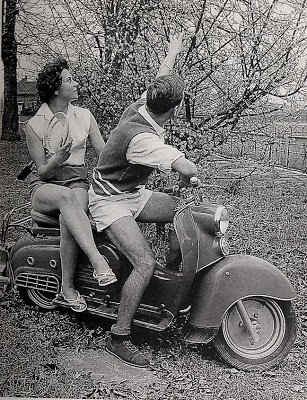 About the same time as they began development of the KS601, Zündapp decided to take a look at the scooter craze sweeping Italy. After testing various prototypes based on some of the more popular Italian designs, Zündapp introduced the R150 “Bella” scooter in 1953. Powered by an air cooled 146cc two-stroke single, featuring 6v electrics with a kick starter and an undamped telescopic fork. The fuel tank was mounted under the seat. Characterized by a very large front fender with a slim rear end and a tubular motorcycle-like frame, the design of the Bella was heavily influenced by that of the Italian Parilla Levriere (Parilla Greyhound).
In 1955 an electric start version of the 200cc model was released along with a special USA-only model called the Suburbanette. Substantially changed for the American market, the Suburbanette wasn’t nearly as popular as the original model and only 370 were sold.
The R201, which arrived later in 1955, had more curvy styling than the original R200 and a new carburetor. Also a Steib sidecar made was available as a dealer option- the sturdy frame made it an ideal platform for a sidecar. In 1956 Zündapp released the R153 and R203, followed by the R154 and R204 in 1957, each having a slightly larger engine than the previous year. The last 150cc Bella was manufactured in 1958, but the 200’s were continued until 1962; a 175cc model, the R175S, was introduced in 1961 and continued through 1964.
 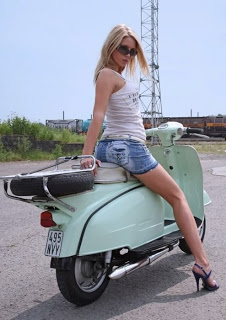  But by 1955 the looming crisis in the European motorcycle industry was already on the horizon. Realizing that compact cars were in much higher demand than motorcycles Zündapp made a last attempt to break into the market; the company settled for a micro-car designed by Dornier Flugzeugwerke that featured both a forward-opening door for the front seat and a rear-opening door for the rear-facing passenger seat; this “coming or going” design was given the name of the two faced Roman god Janus.
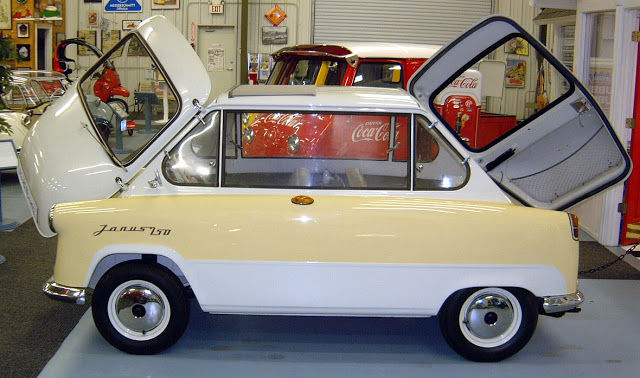 |
| Zündapp Janus |
The Janus was powered by a mid-mounted 2-stroke single cylinder 245cc engine developing 14 hp (10 kW), enabling a top speed of 80 km/h. The problem with the mid-engine configuration (which usually leads to optimal handling) was that the engine was lighter than the rear passengers, and that lead to a variable center of gravity. Production started in June 1957 but only 1,731 cars were sold in the first six months. By mid-1958 Zündapp abandoned the project and sold the factory to Bosch after producing only 6,902 cars.
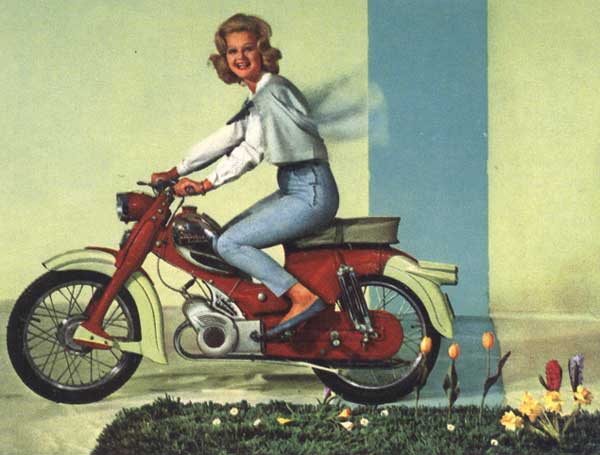 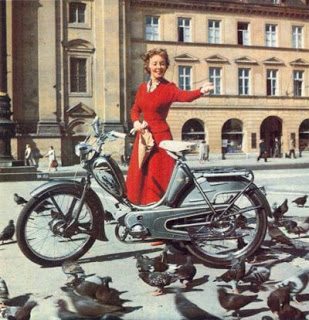 After the failure of the Janus project drastic measures were taken to try and rescue the ailing company; the motorcycle, car and sewing machine production facilities in Nuremberg were abandoned in 1959 and the company headquarters was moved to Munich. The workforce was reduced by half, but the decline could not be stopped. For the next decade production was focused on mopeds and light motorcycles.
Germany and Austria had a specific “moped” motorcycle classification (category IV), limited to a 50cc maximum engine capacity. Moped licenses were easily acquired by 16-year-olds with no other driving permits, but the market had been largely ignored as mopeds had also been required by law to weigh less than 33kg.
In 1953 Zündapp had released the Combimot KM48, an auxiliary engine for bicycles, and when the weight restriction was removed in 1955 the company rushed to take advantage of an expanding market. The KM48 was mounted in a tube steel frame, fitted with pedals and a chain drive and became the Combinette.
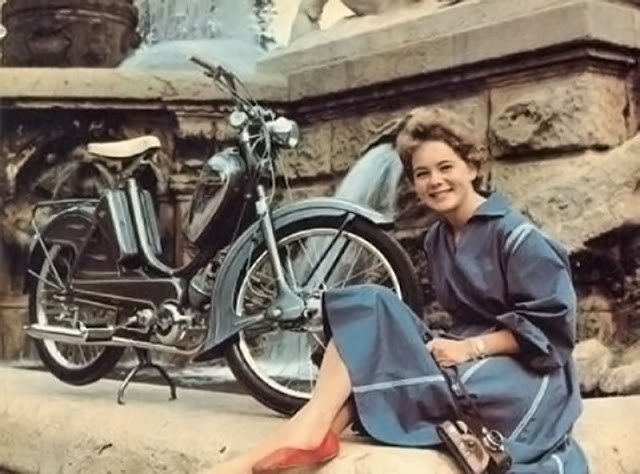 |
| Zündapp Combinette |
By 1962 this had evolved into the KS50; featuring a three-speed gearbox, all-wheel suspension and a central tube frame with the rear portion die-cast in aluminum, this heralded a new era for Zündapp and the chassis design would remain standard until 1984. In 1970 hp was increased to 6.25, the brakes were upgraded and the gears increased from three to five.

By 1967 the German market share of Zündapp motorcycles was down to 33%. Even though the factory had diversified into other products such as boat engines, sewing machines and lawn mowers they were unable to compete against low cost, high volume imports – especially from Asia. Additionally, their focus on two-stroke machines and outdated designs couldn’t compete with the modern designs coming from their competition. Large capacity Japanese four-stroke motorcycles were not as robust, but they were what the buying public wanted.
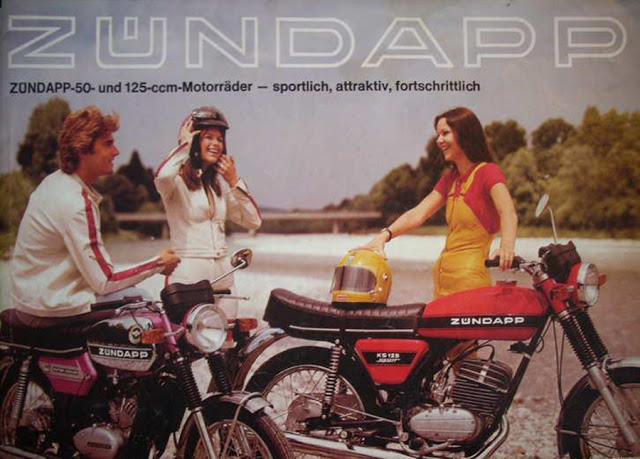   The Zündapp GmbH filed bankruptcy in August 1984 and the production was sold for DM 16 million to Xunda Motorcycle Co. in Tiajin China; Xunda continued to produce small motorcycles under the Zündapp name from 1987 until the early 1990s. In Portugal the FAMAL and Casal companies produced Zündapp engines under license: Casal marketed their Solo and Mars 50cc mopeds in Germany through mail order houses.
Today the Chinese Zündapp company is still in business, producing Honda based 4-stroke motorcycles and electric mopeds. |
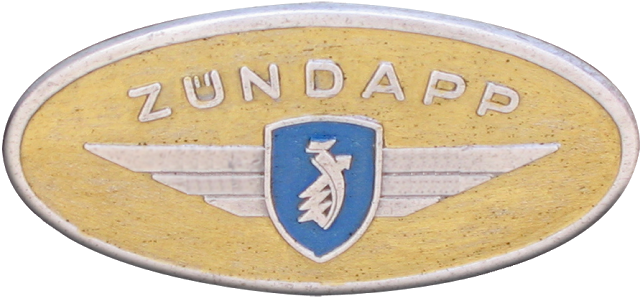
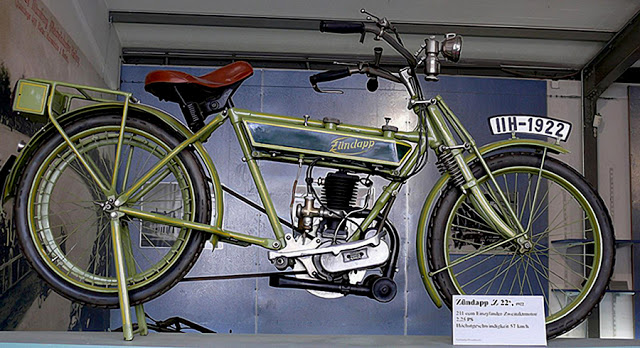
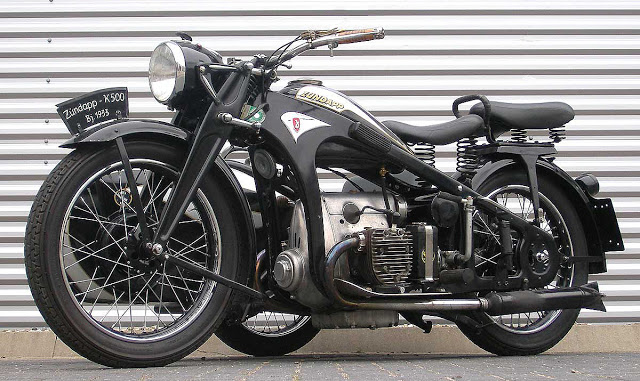
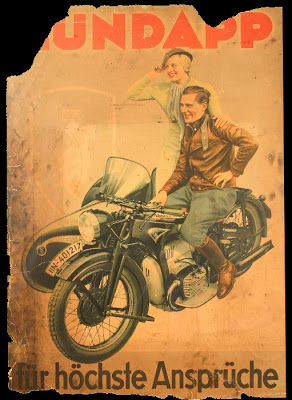
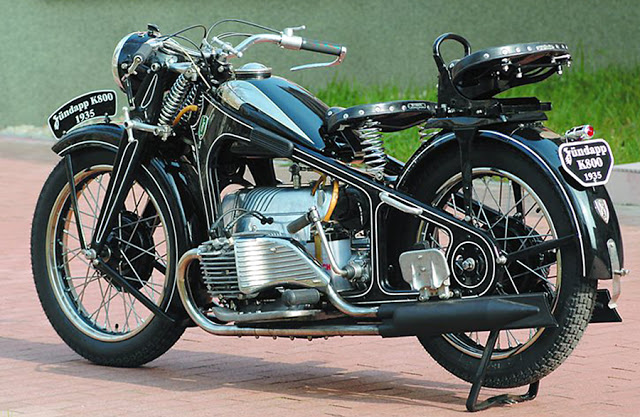


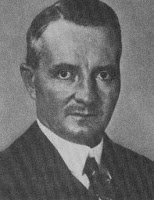



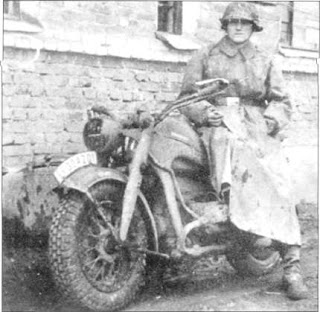
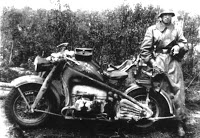





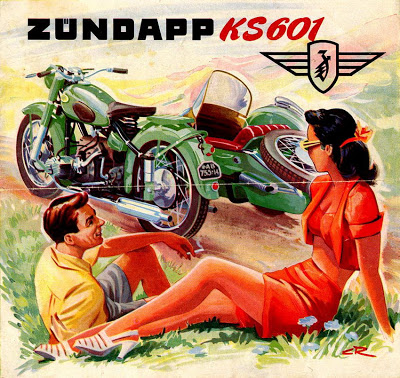


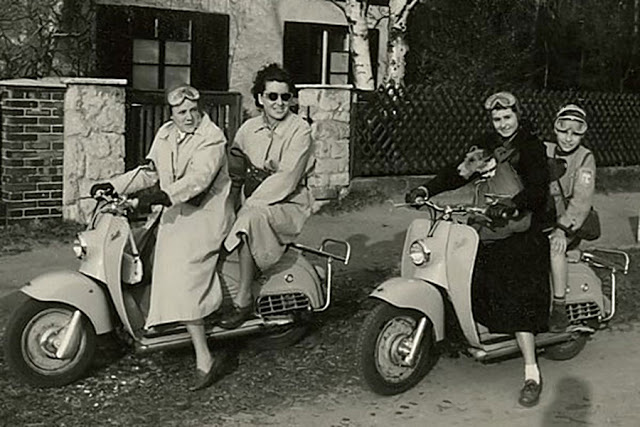










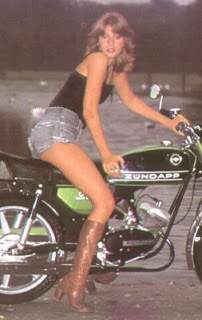

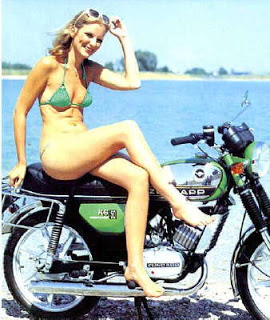
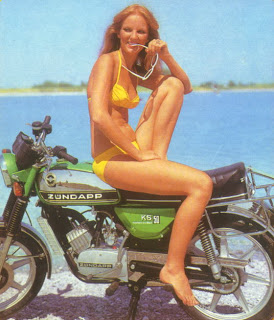
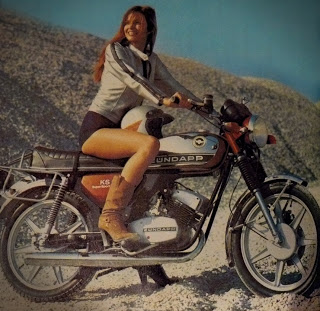
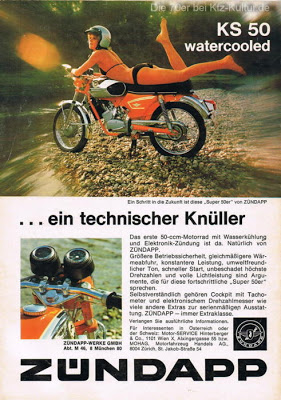
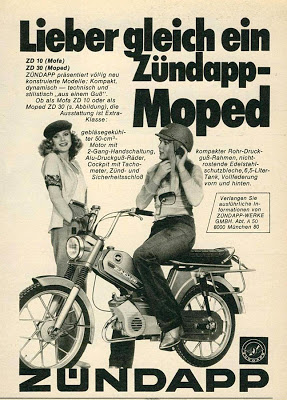
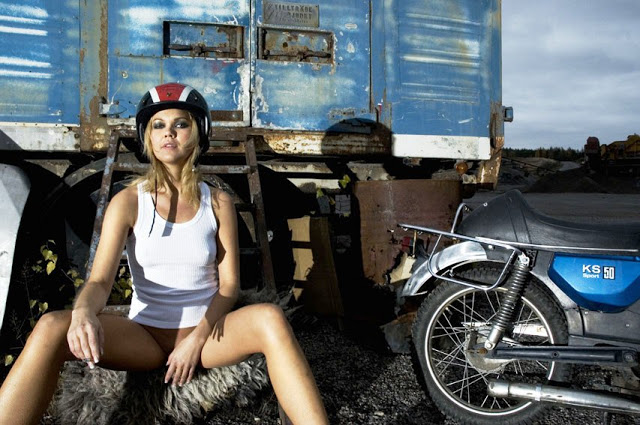



I truly like to reading your post. Thank you so much for taking the time to share such a nice information.
custom choppers
You have linked to germanmotorcycles.cl, a Nazi apologist.
“It is the more amazing how easily these very same abused working masses were mobilized against Hitler-Germany, a nation which treated its workers with dignity, respect and paid them well – including full medical care, world-class education, paid holidays, subsidized public transportation the likes of which no other country has ever enjoyed and economic conditions in general so far superior, it makes the Zeitgeist-whore historians blanch with fury; to top it all off factory management was never overpaid. One wonders about the stupidity of man, one really does —“
I was unaware of the website’s political aspects, thanks for pointing it out.
In 1983, the Indian motorcycle manufacturer Enfield India Ltd , obtained license from Zundapp to produce ZE50. CS50 , KS100 and KS 175 (water-cooled engine) in India. Till about 1990 they made ZE50 and CS50 in some few thousands. During those years scooters were in much demand, and motorcycles made up a small fraction. Enfield wound up manufacture of these Zundapp motorcycles sometime in early 90s. They continued with production of another four-stroke motorcycle , licensed from Royal Enfield (UK) in around 1956; and its variant is sold even today.